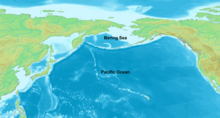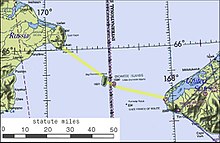Bering Strait Tunnel

The Bering Strait Tunnel is a repeatedly planned transport link between the Russian Chukotka and the US Alaska . The first plans for a tunnel under the Bering Strait date back to 1905. The plans from 2007 see the approximately 100-kilometer-long tunnel as part of a 6000-kilometer-long road between Yakutsk and Alaska, which includes both a broad - gauge high-speed railroad and a motorway as well as power lines and pipelines and should include data cables. One possible route crosses the Bering Strait over the Diomedes Islands .
Historical forerunner
In 1905, the French engineer Loic de Laubel first proposed a 103-kilometer tunnel that would connect Russia with its former colony of Alaska, which was sold to the United States in 1867 for 7.2 million dollars . By 1906, a consortium of American, French and Russian supporters had raised $ 6 million. Nicholas II , the last tsar of Russia, gave his approval; the tunnel seemed too expensive to him (he was then the richest person in the world). After the beginning of the First World War and the October Revolution (1917) the project was suspended.
Project idea TKM-World Link
In April 2007 an economic project called TKM-World Link ( Russian : ТрансКонтинентальная магистраль, TransContinental Magistrale ) to tunnel under the Bering Strait was announced. According to plans by the Council for Production Force Studies in the Russian Ministry of Economic Affairs and the Russian Science Academy, the entire project could be implemented in 10 to 15 years. The construction costs are estimated at 65 billion dollars. The planned tunnel would have a length of 104 kilometers, around twice as long as the English Channel tunnel . At the narrowest point of the Bering Strait (the two coasts are 82.4 kilometers apart), it should run around 80 meters below the seabed and accommodate both a broad-gauge railway line and a motorway. Power lines, pipelines and data cables are also planned. Annually, 70 million tons of freight could be transported through the tunnel.
In 2001, the then Russian Transport Minister Nikolai Aksjonenko expressed skepticism about the project and assessed the feasibility with the words "rather to Mars than to Alaska" as very low. He saw the problem not only in the construction of the tunnel under the Bering Strait, but also in the fact that over 1000 kilometers of rail links would have to be built on permafrost on both sides of the tunnel (see Arctic Circle Railway ).
After its completion, 25 percent of the tunnel will remain in the possession of the Russian state and the United States, with the remaining shares going to private investors and international financial agencies. According to the Russian Ministry of Economic Affairs, potential investors include Russian Railways and the pipeline operator Transneft . Chinese, Japanese and South Korean investors have also already expressed interest in the project.
According to press reports, Russian President Dmitri Medvedev gave the “green light” for the tunnel construction in August 2011.
Chinese idea from 2014
In May 2014, it was reported that Chinese engineers had voiced the idea of building a tunnel under the Bering Strait and a 13,000-kilometer route for high-speed trains with a top speed of 350 kilometers per hour from northeast China through eastern Siberia , Alaska and Canada to the United States . This is technically possible today, and Russia would support such a project. The trip would take less than two days.
literature
- Gigantic profit . In: Der Spiegel . No. 36 , 1995, pp. 192 ( online ).
Web links
- The mammoth Bering Strait project , German video by RIA Novosti , August 26, 2010
- The Bering Strait Crossing (English)
Individual evidence
- ↑ By train through the Bering Strait - Russian politicians dream of a rail tunnel between Siberia and Alaska . In: Berliner Zeitung , April 23, 2007, p. 1
- ↑ Jens Hartmann: Russia: A hole - even longer than the Brenner base tunnel. In: DiePresse.com. April 20, 2007, accessed March 16, 2008 .
- ↑ Russia is building the longest tunnel in the world. In: Spiegel Online. April 19, 2007, accessed March 16, 2008 .
- ^ Russia Plans World's Longest Tunnel, a Link to Alaska. In: Now Public. April 18, 2007, archived from the original on March 28, 2013 ; Retrieved September 4, 2009 .
- ↑ wingsch.net
- ↑ nachrichten.at
- ^ Christian Geinitz: On the train from China to America. In: FAZ.net . May 9, 2014, accessed October 13, 2018 .
- ↑ europe.chinadaily.com.cn Bering strait line to US possible, experts say



